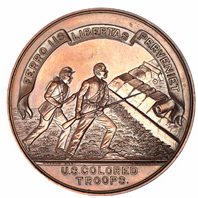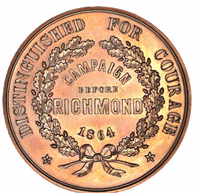
PREV ARTICLE
NEXT ARTICLE
FULL ISSUE
PREV FULL ISSUE
MORE ON THE BUTLER COLORED TROOPS MEDAL
On February 12, 2017 we discussed John Kraljevich's great Facebook series on Black History Month. One of the items highlighted was the General Benjamin Butler Colored Troops Medal. Here's some more information from a February 23, 2017 Numismatic News article by author and researcher R. W. Julian.
-Editor


During 1862 consideration was given in Washington to freeing the slaves but the first step was to authorize black army regiments. The first such units were created in early 1863 and by war’s end 179,000 black soldiers had been enrolled, of which 37,000 died. Most black regiments served in the East, especially in Virginia under Gen.Ulysses S. Grant. The struggle between Grant and Gen. Robert E. Lee was especially fierce in the fall of 1864 with the Union army slowly moving towards the Confederate capital at Richmond. In September 1864, as Grant came closer to Richmond, two key forts barred his way. The resulting Battle of New Market Heights was but one phase of the struggle and involved the use of black troops in a critical manner. The Union general over the black troops was Benjamin Butler, one of the more colorful commanders. When New Orleans was captured by Adm. Farragut in 1862, Butler was appointed military governor. He ruled with an iron fist, even hanging a local gambler who tore down a U.S. flag. He soon acquired the unenviable nickname of “Beast” Butler. While military governor in Louisiana, Butler underwent a change in his view of blacks. At first he considered escaped slaves to be contraband, useful only as workers. Within a few months he saw the value of using blacks as a civil guard, thus freeing up regular troops. Butler then formally suggested raising black regiments for military operations but was told not to interfere in policy decisions. In 1864, however, Butler joined Grant’s command.
The article goes on to describe military events culminating in the battles of Forts Gilmer and Harrison.
-Editor
Butler was so impressed with the black troops at Gilmer and Harrison that he did something no other Union general had done: he decided to have a special medal struck in their honor. To this end he wrote Mint Director James Pollock. At Pollock’s suggestion, Butler contacted Anthony Paquet, a former Mint engraver who had resigned to do private commissions. Paquet prepared the dies and the work was approved by Gen.Butler. In the spring of 1865 the Philadelphia Mint struck 197 silver and 11 copper medals and they were then sent to the Bigelow & Kennard firm in Boston. That company attached a ribbon and hanger to the silver medals; the copper pieces were meant for distribution by Butler but the silver medals, with a few exceptions, had the recipient’s name engraved on the edge. Whenever possible Butler awarded the medals in person to the living recipient or the family in case of the soldier’s death. The obverse shows two black soldiers charging a fort with a Latin legend “FERRO IIS LIBERTAS PERVENIET” (“Freedom will come to them by the sword”) while below is “U.S. Colored Troops.” The reverse has a simple inscription “DISTINGUISHED FOR COURAGE, CAMPAIGN BEFORE RICHMOND 1864” within a wreath. In his memoirs Butler had this to say: “I had the fullest reports made to me of the acts of individual bravery of colored men on that occasion, and I had done for the negro soldiers…what the government has never done for its white soldiers – I had a medal struck of like size, weight, quality, fabrication, and intrinsic value with those which Queen Victoria gave to her distinguished private soldiers of the Crimea…Since the war I have been fully rewarded by seeing the beaming eye of many a colored comrade as he drew his medal from the innermost recesses of its concealment to show me.” These medals are rarely seen today and named silver pieces are of the greatest rarity. They are in strong demand from serious collectors.
To read the complete article, see:
To read the earier E-Sylum article, see:

Wayne Homren, Editor The Numismatic Bibliomania Society is a non-profit organization promoting numismatic literature. See our web site at coinbooks.org. To submit items for publication in The E-Sylum, write to the Editor at this address: whomren@gmail.com To subscribe go to: https://my.binhost.com/lists/listinfo/esylum All Rights Reserved. NBS Home Page Contact the NBS webmaster 
|